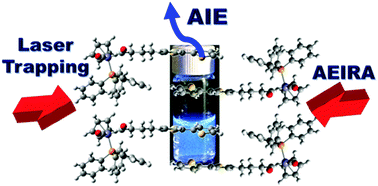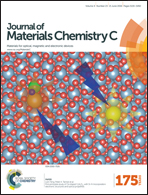Highly-integrated, laser manipulable aqueous metal carbonyl vesicles (MCsomes) with aggregation-induced emission (AIE) and aggregation-enhanced IR absorption (AEIRA)†
Abstract
A highly-integrated, laser manipulable multi-functional metal carbonyl nanovesicle (MCsome) with aggregation-induced emission (AIE) and aggregation-enhanced IR absorption (AEIRA) is created via the self-assembly of a bithiophene tethered-Fp acyl derivative (Fp: CpFe(CO)2) (1). Although 1 is hydrophobic and non-surface-active, the molecule can self-assemble in water into vesicles without detectable critical aggregation concentration (CAC). The water–carbonyl interaction (WCI) is responsible for the colloidal stability. The bilayer membrane structure with the bithiophene moieties associated within the inner wall and the iron-carbonyl units exposed to water is confirmed by transmission electron microscopy (TEM), atomic force microscopy (AFM), and cyclic voltammetry (CV) experiments. The synchrotron small-angle X-ray scattering (SAXS) experiment suggests that the bithiophene groups are interdigitated within the membrane. The spatial segregation of the AIE-active bithiophene domain from the iron-carbonyl units by the butanoyl spacers prevents the quenching effect of the iron and renders the MCsome photoluminescent. The polarizable iron-carbonyl groups on the surface of the MCsome create an enhanced optical field upon infrared (IR) irradiation, resulting in an enhancement (ca. 100-fold) in IR absorption for the carbonyl groups as compared to the same concentration of molecule 1 in THF. When the MCsome interacts with a focused continuous-wave near-IR (NIR) laser beam, a strong gradient (trapping) force is generated allowing the laser trapping of the MCsome without using additives. A sharp contrast in the refractive index (RI) of 1 (RI = 1.71) with water (RI = 1.33) accounts for this laser manipulability that is difficult to be achieved for nanosized liposomes (RI = 1.46). As illustrated, the MCsome of 1 represents a novel group of vesicular colloids, which is amenable to functional materials complementary to extensively studied liposomes and polymersomes.


 Please wait while we load your content...
Please wait while we load your content...